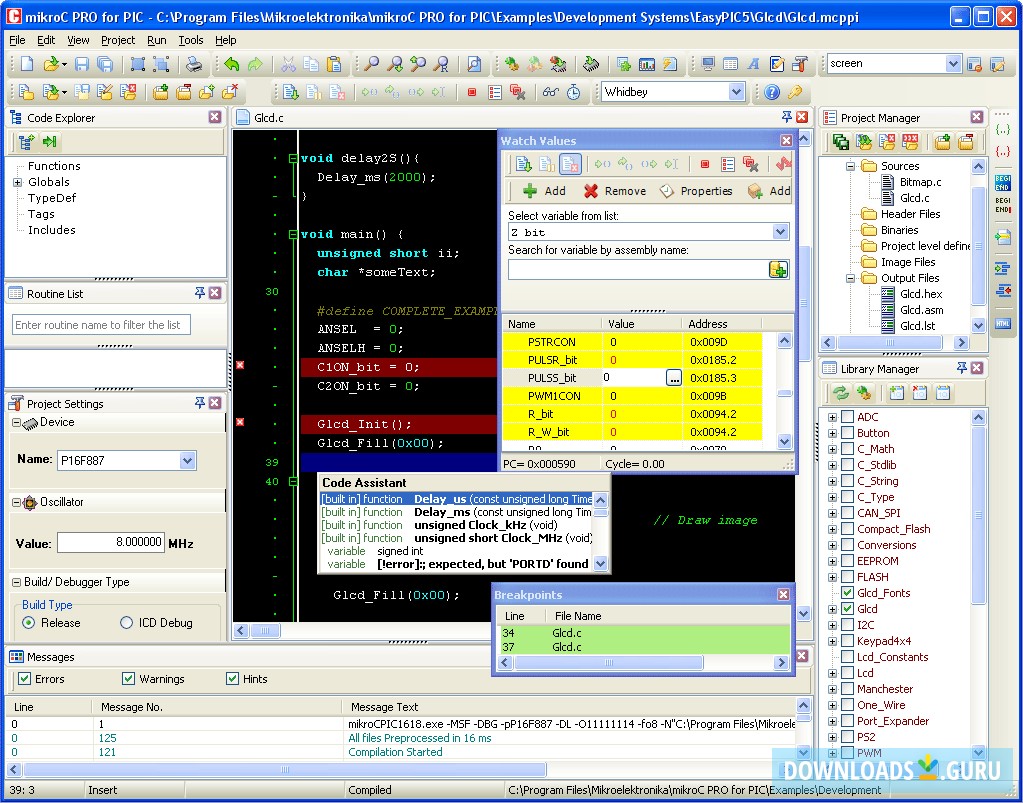- Mikroc Pro For Pic Tutorial
- Mikroc Pro For Pic Library
- Mikroc Pro For Pic 561
- Mikroc Pro For Pic Free Download
- Mikroc Pro For Pic

Interfacing LCD display with PIC microcontroller requires at least 6 data pins (for LCD pins: RS, E, D4, D5, D6 and D7). Number of pins needed for the LCD can be reduced to 2 by using an I2C I/O (Input/Output) expander like PCF8574 or PCF8574A. Adding the I2C I/O expander builds an I2C LCD. The I2C LCD is connected with the microcontroller via 2 lines: SDA (serial data) and SCL (serial clock). I2C = IIC = Inter-Integrated Circuit.
MikroC PRO for PIC is a full-featured ANSI C compiler for PIC devices from Microchip. It is the best solution for developing code for PIC devices. It features intuitive IDE, powerful compiler with advanced optimizations, lots of hardware and software libraries, and additional tools that will help yo. Direct link to download mikroC PIC PRO for free-♥New Video has been uploaded♥MikroC PRO for PIC (Free.
This small post shows an example for connecting LCD (with HD44780 or complaint controller) with Microchip PIC12F1822 8-bit microcontroller, this microcontroller has only 8 pins of which 5 can be used as outputs, therefore an I2C LCD is required.
This project works also with DFRobot I2C LCD displays.
The compiler used in this project is mikroElektronika mikroC PRO for PIC. An I2C LCD driver for mikroC PRO for PIC compiler is required to simplify example C code. This driver is just a C file named (with extension) I2C_LCD.c, we’ve to add this file to project folder, download link is below:
I2C LCD driver for mikroC PRO for PIC compiler

Related Project:
PIC MCU with I2C LCD and DS3231/DS1307 RTC | mikroC Projects
Hardware Required:
The components listed below are required for this project.
- PIC12F1822 microcontroller —-> datasheet
- LCD screen (16×2, 20×4 …)
- PCF8574 I/O expander (or PCF8574A) —-> PCF8574 datasheet
- 5 x 10k ohm resistor
- 330 ohm resistor
- 10k ohm variable resistor or potentiometer
- 5V source
- Breadboard
- Jumper wires
Interfacing PIC12F1822 microcontroller with I2C LCD circuit:
Example circuit schematic diagram is shown in the image below.
(All grounded terminals are connected together)
The PIC12F1822 microcontroller has one hardware I2C module with SDA on pin RA2 (#5) and SCL on pin RA1 (#6). SDA and SCL pins of the PIC12F1822 MCU are connected to SDA (#15) and SCL (#14) pins of the PCF8574 I/O expander respectively.
A2, A1 and A0 pins of the PCF8574 are connected to +5V (each one through 10k resistor) which means the I2C address of the PCF8574 (therefor the I2C LCD) is: 0 1 0 0 A2 A1 A0 0 = 0 1 0 0 1 1 1 0 = 0x4E. The 10k ohm resistors for A2, A1 and A0 are optional and each pin can be connected directly to +5V.
PCF8574A can be used instead of the PCF8574, the I2C address becomes: 0x7E.
In this project the PIC12F1822 microcontroller runs with its internal oscillator @ 8 MHz, MCLR pin is configured as an input pin.
Mikroc Pro For Pic Tutorial
Interfacing PIC12F1822 microcontroller with I2C LCD C code:
The following C code is for mikroC PRO for PIC compiler, it was tested with version 7.2.0.
The I2C LCD driver file is included with the line:
#include “I2C_LCD.c”
Mikroc Pro For Pic Library
The hardware I2C module of the PIC12F1822 is initialized with a clock frequency of 100KHz (100000Hz):
I2C1_Init(100000);
The I2C LCD is initialized with an I2C address of 0x4E:
LCD_Begin(0x4E);
Mikroc Pro For Pic 561


Full mikroC code:
Configuration words:
CONFIG1 = 0x3F84
CONFIG2 = 0x1613